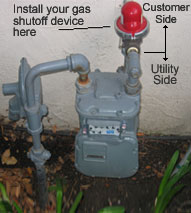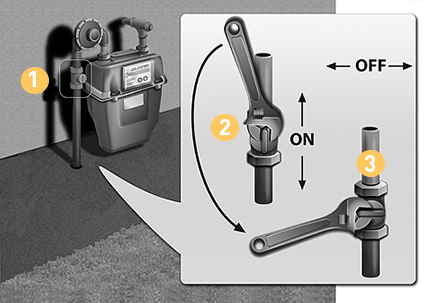You can safety turn off the gas during an emergency by following a few simple guidelines.
Report a gas outage
What to do if you suspect a gas leak
Report any signs of a gas leak immediately. Do not use anything that could be a source of ignition, including cell phones, flashlights, light switches, matches or vehicles, until you are a safe distance away. Your awareness and action can improve the safety of your home and community.
If you are experiencing a gas outage, please call the PG&E Customer Service Line at 1-800-743-5000.
- About PG&E's natural gas system
- When and how to turn off the gas
Explore our natural gas system and get to know how gas pipeline safety is our top priority.
Natural gas safety tips
Gas safety is important, and being prepared can you help avoid dangerous situations. Find out:
- What to do if you suspect a gas leak
- How to detect carbon monoxide
- How to turn off your gas in an emergency
- Other valuable advice
Explore tips to help you stay safe around gas.
To stop the flow of gas into a building during an emergency, turn your gas off at the service shut-off valve. View instructions to turn off your gas. PG&E installs gas service shut-off valves at all gas meter locations.

Preparing to turn off the gas
Follow these guidelines when preparing to turn off the gas.
Most gas appliances have a gas shut-off valve located near the appliance that lets you turn off only the gas to that appliance. Find out which of your appliances use gas and where the appliances’ gas shut-off valves are located. In some cases, you need only turn off the gas at the appliance’s shut-off valve.
How to turn off your gas

Step 1: Locate the main gas shutoff valve
Your main gas shutoff valve is normally located near your gas meter. The most common places are on the side or front of a building, a cabinet located inside a building or a cabinet meter outside a building.
Step 2: Have a wrench handy
Keep a 12- to 15-inch adjustable pipe wrench or crescent wrench available to close the valve in an emergency. Earthquake wrenches with fixed openings may not fit your valve, so an adjustable type is ideal. To minimize the possibility of an unauthorized person tampering with the valve, do not keep wrenches near the gas meter. Shut-off the flow of gas only if you:
- Smell gas
- Hear gas escaping
- See a broken gas line
- Suspect a gas leak
Step 3: Give the valve a quarter turn
To turn off the gas, rotate the valve one-quarter turn in either direction. The valve is closed when the tang (the part on which the wrench is placed) is crosswise to the pipe.
If your gas service is set up differently from the one described and you wish to know how to turn off your gas, please contact PG&E at 1-800-743-5000.
Note: Once you have shut off the gas at the meter, do not try to turn it back on yourself. If the gas service shutoff valve is closed, PG&E or another qualified professional should perform a safety inspection before the gas service is restored and appliance pilots are relit.
Regulate your automatic shut-off device
Some city and county regulations require the installation of automatic gas shut-off devices. This installation may include excess flow gas shut-off valves and/or earthquake-actuated gas shut-off valves. The regulations can vary, but generally apply to:
- New building construction
- Significant alterations
- Additions to existing buildings
Check with your local city or county agency to see if regulations apply in your area.
If a customer installs an excess flow gas shut-off valve or earthquake-actuated gas shut-off valve, the valve must be certified by the State of California. A licensed plumbing contractor must install it according to the manufacturer’s instructions. We do not install or service seismic-actuated or excess flow gas shut-off valves. We do not recommend specific contractors for installation.
Excess flow gas shut-off valves and earthquake-actuated gas shut-off valves must be installed on the building’s gas houseline piping. This pipeline is the gas pipe that connects your appliances to the gas meter downstream of the utility point of delivery. It is located after the PG&E gas shut-off valve, pressure regulator, meter and the service tee. No attachments or connections of any kind are allowed on the utility facilities before the point where the service tee connects to the gas houseline piping. After installation, the valve must not obstruct any gas operations or PG&E services in or around:
- Piping
- Gas service shut-off valves
- Gas meters
- Gas pressure regulating equipment
The State of California requires approval for all excess flow gas shut-off valves and earthquake-actuated gas shut-off valves used within the state. A list of approved valves is available. Visit DSA Gas Shut-off Valves Certification Program.
Ask a pro to turn the gas back on
A closed gas service shut-off valve or automatic gas shut-off device can delay the restoration of your service by PG&E.
Please do not turn the gas on, yourself. Ask a PG&E representative or another qualified professional to perform a safety check, restore gas service and relight your appliance pilots, even if an earthquake did not cause the closure.
More on outage preparation and support
Emergency planning
Know what to do when outages or unexpected events occur.
Community Resource Centers (CRC)
Find a center to access power, restrooms, charging, Wi-Fi or snacks, if your county is impacted by a Public Safety Power Shutoff (PSPS).
211
211 is a free, confidential service available to anyone.Get 24/7 support to connect you with local resources.
